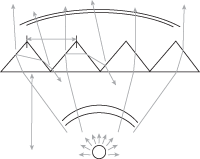In order to maintain a high standard of quality and to meet the ever-increasing demand for flexible and customised solutions, we have an in-house laboratory equipped with all the necessary instrumentation for testing product construction and regulatory parameters. All Arianna's products are tested to obtain a high Life-Time and to ensure the maintenance of the lighting performance so as to guarantee our partners a substantial reduction in costs related to maintenance and replacements.
In Arianna's laboratories there is a machine to test the mechanical resistance of our products and verify the IK level of each one. The IK level tester makes it possible to ascertain the robustness of the lighting body, making it a reliable and long-lasting product.
We perform the IP rating test in-house. This test is used to measure the impermeability of the product to dust and liquids, and is based on the international classification system for the effectiveness of sealing against the penetration of foreign bodies into the equipment.
Other tests underway:
• mechanical strength
• static load (wind) test for fittings and fixings
• thermal tests up to 50ºC
• insulation resistance
• dielectric strength
• earth continuity
• power measurements
• resistance to corrosion (salt spray)
The goniophotometer, which our R&D department uses for all necessary measurements, helps to measure the intensity and spatial distribution of LED light beams. It records the photometric curves of our luminaires to enable us to respond in the best possible way to every customer's lighting requirement.
The Arianna quality department has established tests and testing plans to ensure high product quality. Arianna certifies the compliance of its products with the international regulations in force, also through periodic tests carried out by certified outside laboratories, recognised by ACCREDIA. Arianna can provide its customers with all the reports relating to the photometric, colorimetric and electrical characteristics of its luminaires, while the ENEC mark is issued by a third-party certification body (UL).
Total Reflection differs from simple reflection, used in common reflector optical systems, in that a luminaire, to be considered 'total reflection', must have the light spectrum of at least one of the LED sources totally reflected by at least one of the reflective surfaces, and totally reflected back to the outside. For this to happen, at least one of the LEDs must be surrounded by reflective surfaces so that all of the emitted light is reflected.
The advantages of Total Reflection are high visual comfort, total absence of glare and high energy savings. Since the light sources remain hidden and the eye is not fatigued by annoying beams of light, the eye benefits from an illuminated environment without disturbance.
Arianna's aim has always been to find the balance point between the best possible lighting and maximum energy saving, trying to move this balance point ever higher. It is a continuous striving for innovation and improvement, both in terms of process and result.
• IEC/EN 60598-1 Luminaires
• IEC/EN 60598-2-3 Luminaires for road and street lighting
• IEC/EN 60598-2-5 Floodlights
• IEC/EN 62031 LED modules
The Arianna R&D department uses the best design software. 3D CAD solid modelling is enhanced by simulations of product durability, natural frequencies and heat transfer, so as to optimise the product and ensure high performance
The reflectors that manage the LED light sources are designed in-house. Continuous collaboration between the departments means we can identify the best optics for each project, so as to minimise energy consumption and thus prevent waste while protecting the environment. Light only where it is needed, without shadow areas
To ensure reliability and maximise product performance, careful selection of the components is essential. After being verified by our engineers, light sources, drivers and power supplies are tested by third parties to confirm their performance
The use of components with specific mechanical and electrical characteristics is the basis for guaranteeing optimum results, in compliance with the test procedures to which the devices are subjected
Over the years, Arianna LED has structured itself into departments with key figures for each area of activity: from the technical to the commercial area, from marketing to lighting design. Constant comparison and training, together with common goals and values, are the basis for teamwork in which enthusiasm is the driving force for the final result.

Adopting this Management System for Quality means set rules and procedures that give the possibility to manage more efficiently structural, humans and economic resources through a careful planning and supervised activities

It consists of a reflector that collects and mixes the light emissions using one optical medium, and then projects the light uniformly using a second one. Applied in its basic form above all for street lighting, this system ensures uniform illumination, with no shadow areas, no glare and no dazzle

The system, modulating the optical principle of Schmidt Cassegrain telescopes, collimates the far-field light beams. Generating an intense luminous flux, it is applied for light tower illumination

It uses one optical assembly to collect the LED light emissions, and a second optical assembly that acts as a Fresnel lens, using reflection and not refraction. This system is applied on solutions that require projection lighting over shorter distances
Via dell’industria 17/A – 35028
Piove di Sacco (PD)
+39 049 738 9920
ITA – infoexport@ariannaled.com
WW – infoexport@ariannaled.com
PEC: ariannaled@pec.it
SDI: W7YVJK9
P.I. 04387780283